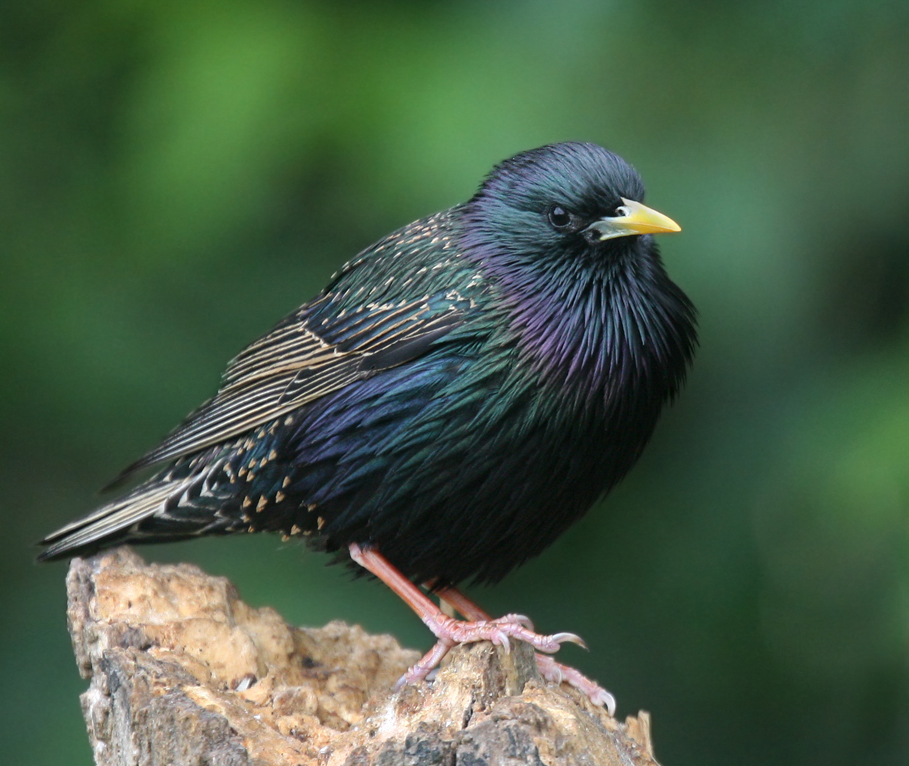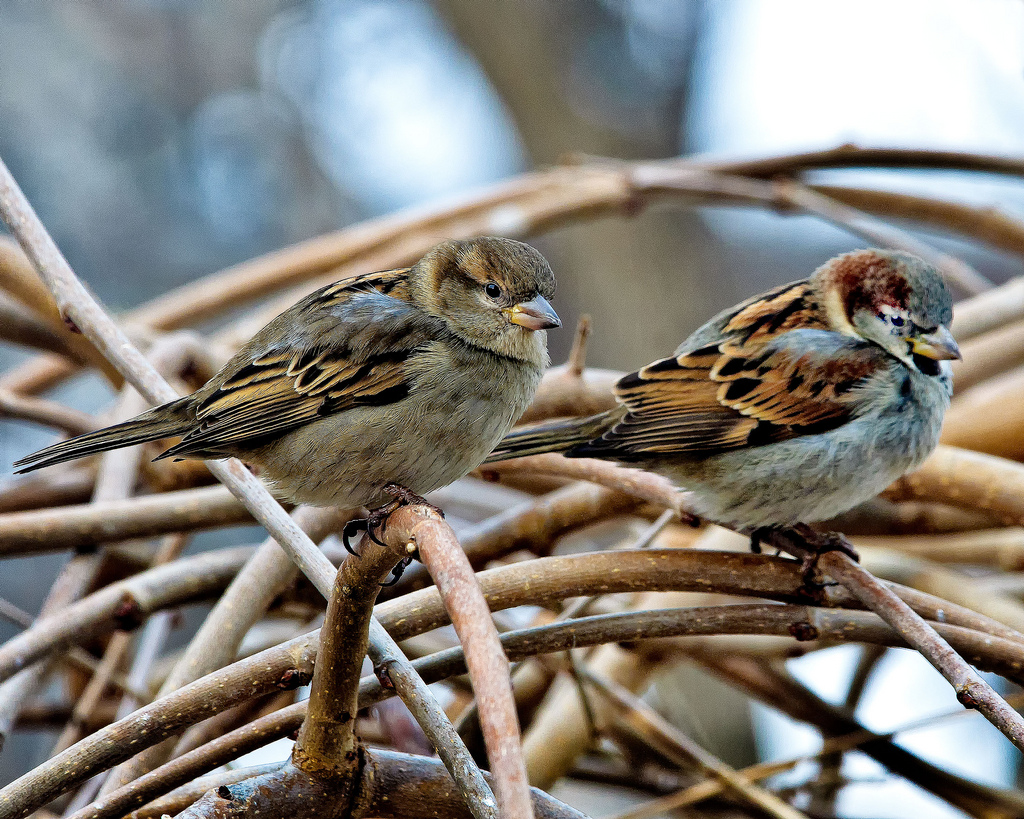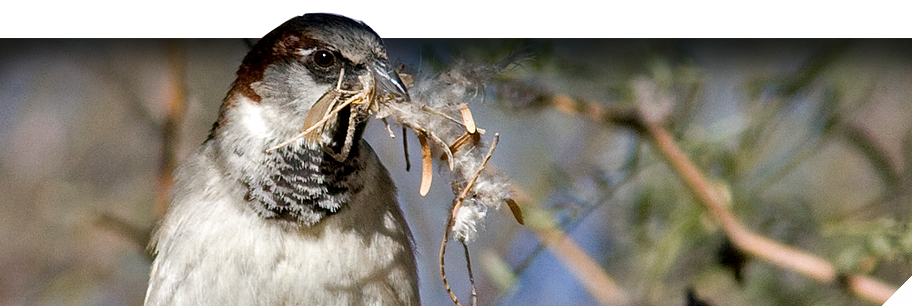Managing House Sparrows and European Starlings
Please note that the methods described below are only for controlling House Sparrows (Passer domesticus) and European Starlings (Sturnus vulgaris), which are not protected by the Migratory Bird Treaty Act, and that it is illegal to harm or harass any native species, including their nests and eggs.
Background
Invasive exotic species are those introduced species which benefit from their new environment such that they increase their population range significantly over time. Invasive species are currently recognized as one of the main threats to global biodiversity. House Sparrows and European Starlings were both introduced to North America in the 19th century. They are now permanent residents found across the United States and Canada, almost always near areas of human habitation and disturbance (e.g., cities and suburbs) or areas with a reliable food source, such as barns or granaries. Both species nest in structures ranging from gutters and downspouts to thick shrubs and bushes, but readily use nest boxes when available. They outcompete native cavity-nesting birds, and are known to destroy nests and eggs, and kill nestlings and adults while taking over an occupied nest site. For more information on the biology of these species, please visit these pages.
- All About Birds: House Sparrow
- All About Birds: European Starling

European Starling (sexes alike)
Deterring House Sparrows and European Starlings
As a nest box monitor, your goal is to provide a safe environment for local cavity-nesting species to breed. For the reasons outlined above, we strongly encourage that you do not allow House Sparrows or European Starlings to breed in your nest boxes. We recommend that you take measures to prevent them from breeding in your boxes. Unfortunately, a completely sparrow-proof nest box does not exist. There are several styles that seem to deter the sparrows for a while, but ultimately if these birds are desperate, they will eventually use the box.
Because European Starlings are a larger bird, they are less of a problem when it comes to competition with bluebirds and other smaller cavity-nesting species. Simply restricting the size of the entrance hole of a nest box should be enough to give the smaller birds access while keep starlings out. If your target species are larger cavity-nesting birds, like American Kestrels, you may have to actively deter starlings from your area.
Passive Control
Placement
The most successful method for preventing exotic species from breeding in your nest boxes is simply to move your boxes. Only place your boxes in areas that do not have these birds. House Sparrows and starlings prefer to be near human habitations, and starlings also frequently inhabit agricultural areas with abundant grain. Therefore, placing your nest boxes in natural areas away from densely-populated locations will prevent many non-target birds from ever finding them.
Avoid Feeding
Another simple way to reduce the number of House Sparrows and European Starlings around your property is to avoid feeding them. House Sparrows prefer smaller seeds like millet, cracked corn, and milo, which are plentiful in inexpensive bird seed mixes. European Starlings, on the other hand, like premium black-oil sunflower seeds. Bird enthusiasts must accept that wherever there is abundant food, so too will there be Starlings and House Sparrows. If you do feed wild birds, offer foods that these species do not appreciate, such as safflower for Northern Cardinals, nyjer or “thistle” seeds for finches, and nectar for hummingbirds. Avoid putting out mealworms and suet, and scattering seed on the ground. Feeders with short perches and small ports are also less attractive to these two species.
Exclusion
Starlings cannot squeeze through a hole smaller than 1 1/2”, so an entrance hole of this size or smaller will exclude starlings from boxes intended for smaller birds. House Sparrows can fit through entrance holes as small as 1 1/4”; therefore, most cavity-nesting songbirds using nest boxes are vulnerable to House Sparrow competition. There currently is no scientifically-documented way to exclude House Sparrows that works permanently, but some monitors have observed that Gilbertson PVC boxes are often avoided by House Sparrows. Your best bet may be to use a more active method of managing House Sparrows. If you prefer, you may alternatively choose to offer only boxes that are not as vulnerable to exotics (e.g., chickadee boxes, Chimney Swift Towers, or nesting platforms).
Timing
Because House Sparrows and European Starlings do not migrate, they have a competitive advantage when it comes to having first pick of suitable nest boxes. By waiting to open your nest boxes until migratory birds return, you can ensure that they have a better chance of finding an unoccupied site. Simply plug the entrance hole of your boxes until nesting season begins. Note that this means that your resident chickadees, titmice, and nuthatches may also have to wait for the migrants to return.

Male (right) and Female (left) House Sparrow
Active Control
Because House Sparrows and European Starlings are exotic species, they are not protected by the Migratory Bird Treaty Act. Therefore nest box monitors are legally allowed to remove or harass them. Below we list some humane, legal actions for controlling or deterring these two species.
Nest Removal
Once House Sparrows have started nesting, remove their nesting materials every few days to discourage them. You may have to continue doing this for at least a week before the birds will tire of continually building a nest that is never completed and move elsewhere. While it is true that the birds will eventually seek a new nesting site, a second problem arises if they find a new site in another nest box that contains an active bluebird or swallow nest. House Sparrows will usurp the nest, often killing the inhabitants of the nest box. Therefore, this method works best with a single backyard nest box.
Incubation Fake-out
Another method involves tricking the birds into incubating eggs that will never hatch. The logic behind this method is that the adults will remain occupied with their nest and leave the native birds in your area alone. Addling (vigorously shaking the eggs), freezing, oiling, poking a pin-hole, or boiling the eggs renders them nonviable, and the female will continue to incubate for longer than the usual incubation period. The drawback to this method is the same as if nesting material was removed: the birds will eventually lay another clutch, often in a new nesting site that may contain an active nest. Many experienced nest monitors concede that nest removal and prolonged incubation are temporary stop-gaps and not long-term solutions; they work best once nesting is already initiated by the unwanted species and the monitor is unable to effectively trap the exotics.
Trapping
Where populations of exotic species are high, trapping may be the only effective means of managing invasive species. Once you have a bird trapped, it is best to humanely euthanize it as soon as possible to avoid unnecessary stress to the bird. Sparrow traps must be checked hourly to ensure that no native birds become trapped, and trap operators should have the necessary identification skills to ensure that only House Sparrows are detained. There are several humane methods for trapping exotic birds, such as:
- In-box Trap
- Funnel Trap
- Trio Trap
- Repeating (Elevator) Trap
While no wildlife manager takes pleasure in euthanizing a pest species, it is upsetting and discouraging to find the injured or dead victims of preventable attacks in your nest box. Many raptor rehabilitation facilities will accept sparrows that have been euthanized humanely and without the use of chemicals. The North American Bluebird Society provides additional details on House Sparrow control and may have state or provincial affiliate members who can advise you on effective deterrents for your region, state regulations on wildlife relocation, and local organizations that accept harvested sparrows and/or starlings.
 Photo ©
Photo ©